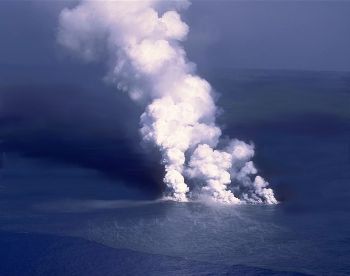by Larry
October, 2004Yellowstone's Looming Little BangWhile, in its record of volcanism, WY's most famous national park is noted primarily for the shattering explosion of 640,000 years ago that created the enormous caldera which today encompasses much of Yellowstone, the geothermal activity of the region has continued rather intensely, with periodic earthquakes and smaller eruptions modifying the area almost without a break. Among the more dramatic of these later events was the eruption 125,000 years ago which created the West Thumb caldera, substantially reshaping Lake Yellowstone and its nearby environs, from which parts of the lake's bottom remain currently quite hot and eruptive to the present.
Not so well known is that there are also, every few thousand years, lesser bangs in Yellowstone, and that another may well be near, one with the potential to ruin many a visitor's whole day.
Scientists do not expect a major lava release in Yellowstone for some time, perhaps millennia, but a sudden, powerful release of steam under great pressure, maybe similar to Mount St. Helen's recent, powerful steam blasts, is quite possible. Indeed, per an online "Smithsonian Magazine" article, "Yellowstone Grumbles," by Kevin Krajick, geologists believe a rise in the level of part of Lake Yellowstone's bed, a lake floor dome first noted in 1999 and now called the "inflated plain," may signal that such a gas eruption is looming, the largest in about 3000 years. Should this occur, substantial boulders as well as a good-sized tsunami could be headed lakeside visitors' way. The inflated plain is 2100 feet long and swells 100 feet above the surrounding lake floor. It is thought to be caused by steam or carbon dioxide trapped and building up under the lake bed, held in for now by lake floor sediments plus the lake's water pressure. It appears to have become larger in the last few years. Volcanologists have not been tracking it long enough to know with accuracy just when it might erupt. There are hundreds of smaller hydrothermal events at Yellowstone, besides the fairly regular geyser eruptions. Among those with potential to cause visitors a headache, at least 20 explosive releases have occurred since 1872 (when research into Yellowstone's activity began). One in 1989, for instance, blew large vehicle-sized rocks out. They rained down around people 200 feet distant (none were hit). As recently as March, 2003, 14 new steam vents dramatically opened up with a roar along a 230-foot stretch north of Yellowstone's Norris Basin. The loud release was accompanied by dense water vapor mixed with powdered glass shards. Ground temperatures rose to 200°F. Attracted by Yellowstone's immense variety and beauty and its windows not only onto our dramatic ancient past but also the planet's ongoing geological dynamism, few prospective park visitors would want to stay away just because there might one day or night soon be a new big Yellowstone event, but scientists find much to hold their interest here, not least the prospect that the inflated plain could well be the source of the next little bang. |
